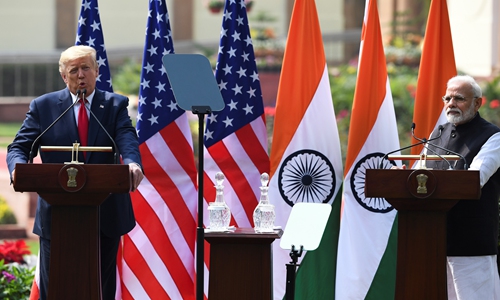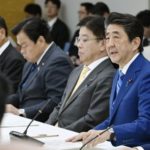US President Donald Trump is the first US president to put forward the Indo-Pacific Strategy, which attempts to combine the Pacific and Indian region in a geopolitical concept. This is because the US is keen on roping in India, a rapidly rising power, into its geopolitical track.
Trump paid his first official visit to India on February 24 and 25, which should have been an important opportunity for Trump to promote his Indo-Pacific Strategy, and underpin US-India strategic cooperation. However, neither Trump’s address nor the joint statement underlined the Indo-Pacific Strategy.
This signals the difficulty the US government has had in promoting its Indo-Pacific Strategy over the past two years.
In attempt to boost this strategy, Washington has made great efforts militarily and diplomatically. The US has roped India into the so-called Quad, which also includes Australia and Japan, to promote quadrilateral consultations on collective efforts to advance a so-called free, open, and inclusive Indo-Pacific. The US Pacific Command was renamed the US Indo-Pacific Command on May 30, 2018.
These moves exemplify the US is fully prepared to use the Indo-Pacific Strategy to construct a grand geopolitical cooperative framework by collaborating with India, Japan and Australia, in an attempt to control a vast region around the Indian and Pacific oceans.
Although New Delhi does welcome the integration of the Indian and Pacific regions, India’s Indo-Pacific geopolitical dream differs from that of the US. Over the past two decades, India has attached increasing importance to the Asia-Pacific region, which can be seen from the upgrading of its policy from “Look East” to “Act East.”
The world’s second most populous country has integrated into the Asia-Pacific region, cooperating on trade, politics, security, and other fields. India is proactively participating in a string of cooperation mechanisms and organizations, such as APEC, the East Asia Summit, the ASEAN Regional Forum and the Shanghai Cooperation Organization, playing a positive role in integrating the Indian and Pacific regions.
India’s vigorous efforts do not stem from the US-proposed Indo-Pacific Strategy, but rather its eastward engagement in accordance with its long-term interests. India’s involvement in the Indian and Pacific regions is conductive to the sustainable and peaceful development of India and the entire region. India’s rapid rise in recent years cannot be separated from its “Look East” and “Act East” policies that are designed to realize India’s own interests and own development, rather than cater to the Indo-Pacific Strategy of the US.
New Delhi and Washington can hardly agree on the Indo-Pacific Strategy which only the latter is keen to promote. As a major developing country, India has long upheld its independence and non-alignment, and has become increasingly reluctant to tie itself to other powers’ geopolitical strategies as its own strength continues to grow.
As Vijay Prashad, director of Tricontinental: Institute for Social Research, wrote in a commentary published by The Hindu on February 24, “To remain the subordinate ally of the US suggests that India will miss an opportunity to be part of a reshaped Asia.”
Trump’s visit witnessed a lively exchange between the two state leaders. The two governments reached consensus on many topics and achieved some outcomes. India signed a military deal to purchase advanced weapons from the US, the two countries agreed to “promptly” conclude their trade negotiations and the US reiterated its support for India to have a permanent seat on the UN Security Council.
As for the Indo-Pacific Strategy however, President Trump returned home empty-handed. Since the US formally proposed and vigorously promoted the Indo-Pacific Strategy, it has encountered resistance not only from India, but also from its decades-old allies Japan and Australia. Both Tokyo and Canberra have been extremely cautious about the US strategy and have insisted on developing their own vision for the region.
With the rise of economic globalization, the integration of economies around the Indian and the Pacific oceans is an irresistible trend and is in line with the desire of the people. Each country has its own ideas about the increasingly integrated Indo-Pacific region. It is obviously impossible to bundle all countries in the region under a single power’s strategy.
The author is a researcher at the China Institute of International Studies. opinion@globaltimes.com.cn




